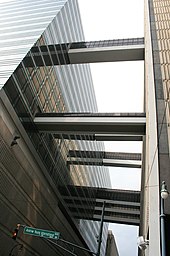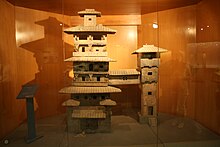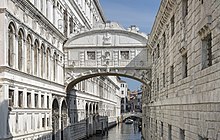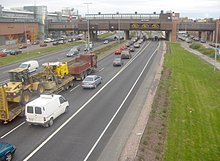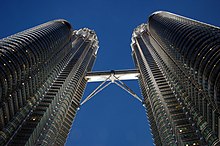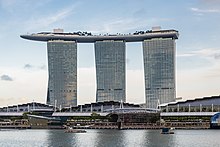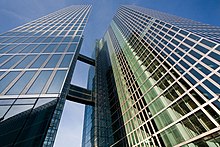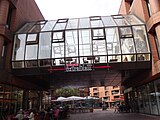
In American English, walkway is a composite or umbrella term for all engineered surfaces or structures which support the use of trails.
An underground city is a series of linked subterranean spaces that may provide a defensive refuge; a place for living, working or shopping; a transit system; mausolea; wine or storage cellars; cisterns or drainage channels; or several of these. Underground cities may be currently active modern creations or they may be historic including ancient sites, some of which may be all or partially open to the public.

Path is a network of underground pedestrian tunnels, elevated walkways, and at-grade walkways connecting the office towers of Downtown Toronto, Ontario, Canada. It connects more than 70 buildings via 30 kilometres (19 mi) of tunnels, walkways, and shopping areas. According to Guinness World Records, Path is the largest underground shopping complex in the world, with 371,600 square metres (4,000,000 sq ft) of retail space which includes over 1,200 retail fronts (2016). As of 2016, over 200,000 residents and workers use the Path system daily with the number of private dwellings within walking distance at 30,115.

A footbridge is a bridge designed solely for pedestrians. While the primary meaning for a bridge is a structure which links "two points at a height above the ground", a footbridge can also be a lower structure, such as a boardwalk, that enables pedestrians to cross wet, fragile, or marshy land. Bridges range from stepping stones–possibly the earliest man-made structure to "bridge" water–to elaborate steel structures. Another early bridge would have been simply a fallen tree. In some cases a footbridge can be both functional and artistic.

The Chicago Pedway is a network of tunnels, ground-level concourses and bridges in Chicago, Illinois connecting skyscrapers, retail stores, hotels, and train stations throughout the central business district.

The Plus 15 or +15 is a skyway network in Calgary, Alberta, Canada. It is the world's most extensive pedestrian skywalk system, with a total length of 16 kilometres and 86 bridges connecting 130 buildings, as of 2022. Calgary often has severe winters and the walkways allow people to get around the city's downtown more quickly and comfortably. The busiest parts of the network saw over 20,000 pedestrians per day in a 2018 count.
A skyway is a suspended covered walkway between buildings.

Pedways are elevated or underground walkways, often connecting urban high-rises to each other, other buildings, or the street. They provide quick and comfortable movement from building to building, away from traffic and inclement weather. Two of the largest networks of underground walkways are located in Canada, with RÉSO in Montreal and PATH in Toronto each consisting of approximately 30 kilometres (19 mi) of underground city-centre walkways.

The Downtown Halifax Link system is a network of climate-controlled pedways connecting various office buildings, hotels, parkades, and entertainment venues around downtown Halifax, Nova Scotia, Canada. It is similar to Toronto's PATH or Montreal's RÉSO system, but on a much smaller scale. These walkways are all open to the public, and are convenient during inclement weather and the winter months.

A greenway is usually a shared-use path along a strip of undeveloped land, in an urban or rural area, set aside for recreational use or environmental protection. Greenways are frequently created out of disused railways, canal towpaths, utility company rights of way, or derelict industrial land. Greenways can also be linear parks, and can serve as wildlife corridors. The path's surface may be paved and often serves multiple users: walkers, runners, bicyclists, skaters and hikers. A characteristic of greenways, as defined by the European Greenways Association, is "ease of passage": that is that they have "either low or zero gradient", so that they can be used by all "types of users, including mobility impaired people".

The Central Elevated Walkway is an extensive footbridge network spanning Admiralty, Central and parts of Sheung Wan, near Victoria Harbour in Hong Kong.
A skywalk is a type of pedestrian bridge

The Winnipeg Walkway System, also known as the Winnipeg Skywalk, is a network of pedestrian skyways and tunnels connecting a significant portion of downtown Winnipeg, Manitoba.

The Edmonton Pedway system is a pedestrian network connecting office buildings, shopping centres, and parkades in downtown Edmonton, Alberta, Canada. It consists of approximately 13 kilometres (8.1 mi) of year-round climate-controlled tunnels, and walkways between the second floors of buildings, approximately 15 feet (4.6 m) above ground. The main network connects more than 40 buildings and parkades, and three of the five Edmonton Light Rail Transit (LRT) stations in the downtown area.

The Minneapolis Skyway System is an interlinked collection of enclosed pedestrian footbridges that connect various buildings in 80 full city blocks over 9.5 miles (15.3 km) of Downtown Minneapolis, enabling people to walk in climate-controlled comfort year-round. The skyways are owned by individual buildings in Minneapolis, and as such they do not have uniform opening and closing times. The 9.5 miles of skyway are comparable to the Houston tunnel system, the systems in Canadian cities such as Toronto's PATH, Montreal's Underground City, Calgary's 11-mile +15 system and the 8-mile Edmonton Pedway system.

The Mumbai Skywalk Project is a series of pedestrian skyways in the Mumbai Metropolitan Region. The skywalks connect Mumbai Suburban Railway stations and other high-concentration commercial areas with various destinations. The purpose of the skywalks is efficient dispersal of commuters from congested areas to strategic locations, such as bus stations, taxi stands, shopping areas, etc. and vice versa.

The Dallas Pedestrian Network or Dallas Pedway is a system of grade-separated walkways covering thirty-six city blocks of Downtown Dallas, Texas, United States. The system connects buildings, garages and parks through tunnels and above-ground skybridges. The network contains an underground city of shops, restaurants and offices during weekday business hours.
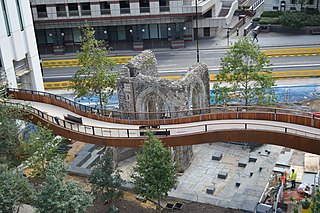
The City of London Pedway Scheme is a largely elevated pedway network that evolved out of a plan to transform traffic flows in the City of London by separating pedestrians from street level traffic using elevated walkways. First devised as part of the post World War II reconstruction plans for London, it was put into effect mainly from the mid-1950s to the mid-1960s, and had been largely mothballed by the 1980s. The scheme was partially revived in 2017 when a new section of walkway was added as part of a development in London Wall.

The Cincinnati Skywalk was a series of walkways, primarily indoors and elevated, that allowed pedestrians to traverse downtown Cincinnati, Ohio.
